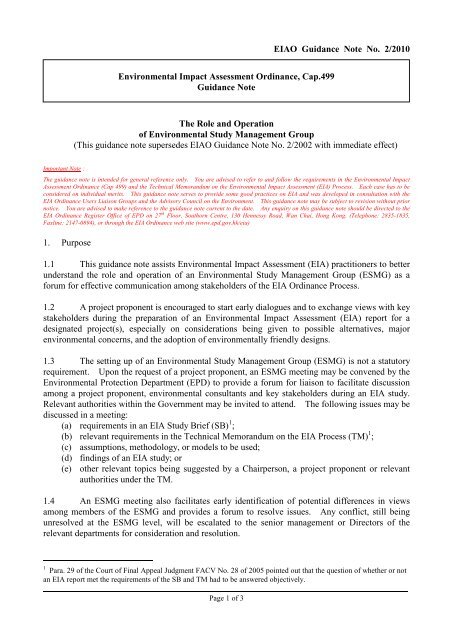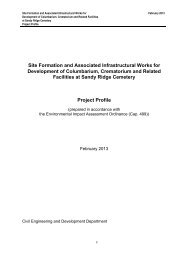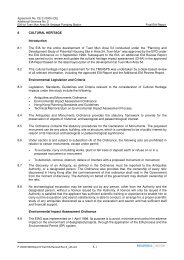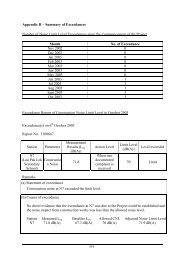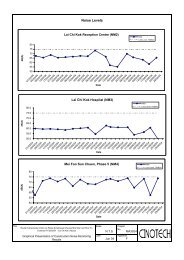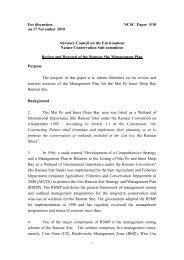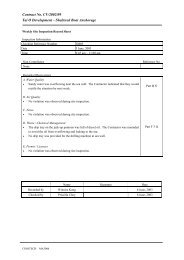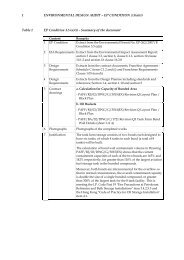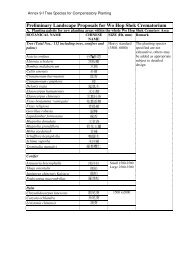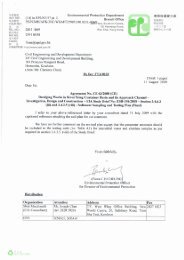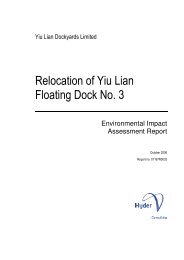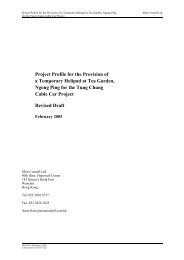The Role and Operation of Environmental Study Management
The Role and Operation of Environmental Study Management
The Role and Operation of Environmental Study Management
Create successful ePaper yourself
Turn your PDF publications into a flip-book with our unique Google optimized e-Paper software.
Important Note :<br />
Page 1 <strong>of</strong> 3<br />
EIAO Guidance Note No. 2/2010<br />
<strong>The</strong> <strong>Role</strong> <strong>and</strong> <strong>Operation</strong><br />
<strong>of</strong> <strong>Environmental</strong> <strong>Study</strong> <strong>Management</strong> Group<br />
(This guidance note supersedes EIAO Guidance Note No. 2/2002 with immediate effect)<br />
<strong>The</strong> guidance note is intended for general reference only. You are advised to refer to <strong>and</strong> follow the requirements in the <strong>Environmental</strong> Impact<br />
Assessment Ordinance (Cap 499) <strong>and</strong> the Technical Memor<strong>and</strong>um on the <strong>Environmental</strong> Impact Assessment (EIA) Process. Each case has to be<br />
considered on individual merits. This guidance note serves to provide some good practices on EIA <strong>and</strong> was developed in consultation with the<br />
EIA Ordinance Users Liaison Groups <strong>and</strong> the Advisory Council on the Environment. This guidance note may be subject to revision without prior<br />
notice. You are advised to make reference to the guidance note current to the date. Any enquiry on this guidance note should be directed to the<br />
EIA Ordinance Register Office <strong>of</strong> EPD on 27 th Floor, Southorn Centre, 130 Hennessy Road, Wan Chai, Hong Kong. (Telephone: 2835-1835,<br />
Faxline: 2147-0894), or through the EIA Ordinance web site (www.epd.gov.hk/eia)<br />
1. Purpose<br />
<strong>Environmental</strong> Impact Assessment Ordinance, Cap.499<br />
Guidance Note<br />
1.1 This guidance note assists <strong>Environmental</strong> Impact Assessment (EIA) practitioners to better<br />
underst<strong>and</strong> the role <strong>and</strong> operation <strong>of</strong> an <strong>Environmental</strong> <strong>Study</strong> <strong>Management</strong> Group (ESMG) as a<br />
forum for effective communication among stakeholders <strong>of</strong> the EIA Ordinance Process.<br />
1.2 A project proponent is encouraged to start early dialogues <strong>and</strong> to exchange views with key<br />
stakeholders during the preparation <strong>of</strong> an <strong>Environmental</strong> Impact Assessment (EIA) report for a<br />
designated project(s), especially on considerations being given to possible alternatives, major<br />
environmental concerns, <strong>and</strong> the adoption <strong>of</strong> environmentally friendly designs.<br />
1.3 <strong>The</strong> setting up <strong>of</strong> an <strong>Environmental</strong> <strong>Study</strong> <strong>Management</strong> Group (ESMG) is not a statutory<br />
requirement. Upon the request <strong>of</strong> a project proponent, an ESMG meeting may be convened by the<br />
<strong>Environmental</strong> Protection Department (EPD) to provide a forum for liaison to facilitate discussion<br />
among a project proponent, environmental consultants <strong>and</strong> key stakeholders during an EIA study.<br />
Relevant authorities within the Government may be invited to attend. <strong>The</strong> following issues may be<br />
discussed in a meeting:<br />
(a) requirements in an EIA <strong>Study</strong> Brief (SB) 1<br />
;<br />
(b) relevant requirements in the Technical Memor<strong>and</strong>um on the EIA Process (TM) 1 ;<br />
(c) assumptions, methodology, or models to be used;<br />
(d) findings <strong>of</strong> an EIA study; or<br />
(e) other relevant topics being suggested by a Chairperson, a project proponent or relevant<br />
authorities under the TM.<br />
1.4 An ESMG meeting also facilitates early identification <strong>of</strong> potential differences in views<br />
among members <strong>of</strong> the ESMG <strong>and</strong> provides a forum to resolve issues. Any conflict, still being<br />
unresolved at the ESMG level, will be escalated to the senior management or Directors <strong>of</strong> the<br />
relevant departments for consideration <strong>and</strong> resolution.<br />
1 Para. 29 <strong>of</strong> the Court <strong>of</strong> Final Appeal Judgment FACV No. 28 <strong>of</strong> 2005 pointed out that the question <strong>of</strong> whether or not<br />
an EIA report met the requirements <strong>of</strong> the SB <strong>and</strong> TM had to be answered objectively.
2. Membership <strong>of</strong> an ESMG<br />
2.1 An ESMG meeting will normally be chaired by a Directorate Officer from the EPD, with<br />
members from a project proponent, environmental consultants (if any), relevant specialist groups in<br />
the EPD, <strong>and</strong> relevant authorities within the Government.<br />
3. Arrangement for a Meeting<br />
3.1 To set up an EMSG meeting, a project proponent <strong>and</strong>/or environmental consultants should<br />
approach the subject <strong>of</strong>ficer (normally the <strong>Environmental</strong> Protection Officer or the Senior<br />
<strong>Environmental</strong> Protection Officer responsible for a designated project) in the <strong>Environmental</strong><br />
Assessment Division <strong>of</strong> the EPD to schedule an appropriate time for a meeting. <strong>The</strong> EPD would<br />
endeavour to arrange a meeting within a month subject to the availability <strong>of</strong> representative ESMG<br />
members. At least one week in advance <strong>of</strong> a meeting, a project proponent should provide the EPD<br />
with a list <strong>of</strong> specific issues, <strong>and</strong> related paper(s)/report(s), which he/she intends to discuss or seek<br />
clarification at a meeting. This should form part <strong>of</strong> a meeting agenda being prepared by the EPD<br />
for distribution to relevant members for their early consideration <strong>and</strong> preparation.<br />
4. <strong>Management</strong> <strong>of</strong> an ESMG<br />
4.1 A relevant directorate <strong>of</strong>ficer(s) from the EPD is responsible for chairing the ESMG<br />
meetings, overseeing the EIA process <strong>and</strong> resolving any issues <strong>of</strong> conflict. In general, the subject<br />
<strong>of</strong>ficers for a designated project in the <strong>Environmental</strong> Assessment Division <strong>of</strong> the EPD are the focal<br />
point for liaison with a project proponent <strong>and</strong> environmental consultants.<br />
4.2 To facilitate the preparation <strong>of</strong> a meeting, relevant authorities <strong>and</strong> specialists are<br />
responsible for providing the subject <strong>of</strong>ficers with updated information <strong>and</strong> comments on the<br />
paper(s)/ report(s) being submitted by a project proponent. To avoid confusion <strong>and</strong><br />
mis-underst<strong>and</strong>ing, no information flow should by-pass the subject <strong>of</strong>ficers or the project proponent.<br />
5. Initiation <strong>of</strong> an ESMG<br />
5.1 <strong>The</strong> EPD encourages a project proponent to initiate an ESMG meeting as early as possible,<br />
even before the commencement <strong>of</strong> the statutory EIA process so that considerations <strong>of</strong> possible<br />
alternatives, major environmental concerns, <strong>and</strong> adoptions <strong>of</strong> environmentally friendly designs can<br />
be discussed.<br />
ESMG meetings before Submission <strong>of</strong> EIA Report under EIAO<br />
5.2 An ESMG meeting, if being convened before the formal submissions <strong>of</strong> an EIA report<br />
under the EIA Ordinance, is to be conducted only on an administrative <strong>and</strong> advisory basis so as to<br />
help a project proponent to underst<strong>and</strong> requirements under the EIA Ordinance. <strong>The</strong> discussion <strong>and</strong><br />
liaison at a meeting shall not in any case absolve the responsibilities <strong>of</strong> a project proponent in the<br />
EIA Ordinance. Any formal submissions by a project proponent under the Ordinance shall be<br />
h<strong>and</strong>led in accordance with the procedures <strong>and</strong> requirements in the EIA Ordinance <strong>and</strong> the TM.<br />
<strong>The</strong> priority <strong>of</strong> <strong>of</strong>ficers in EPD <strong>and</strong> other relevant authorities would be given to those applications or<br />
reports formally submitted under the Ordinance.<br />
Page 2 <strong>of</strong> 3
ESMG meetings after Submission <strong>of</strong> EIA Report under EIAO<br />
5.3 Except for a straightforward case, the EPD will convene an ESMG meeting for a project<br />
with a project proponent, environmental consultants, <strong>and</strong> other relevant authorities to discuss an<br />
EIA report being submitted under the EIA Ordinance.<br />
5.4 An ESMG meeting being convened after submission <strong>of</strong> an EIA report under the EIAO is<br />
simply a liaison channel for a project proponent <strong>and</strong> environmental consultants to present their<br />
assessment findings <strong>and</strong> recommendations to the EPD <strong>and</strong> relevant authorities. <strong>The</strong> discussion<br />
<strong>and</strong> liaison at a meeting shall not in any case absolve the responsibilities <strong>of</strong> a project proponent as<br />
stipulated in the EIA Ordinance.<br />
<strong>Environmental</strong> Protection Department<br />
Date <strong>of</strong> Issue : December 2010<br />
Page 3 <strong>of</strong> 3


